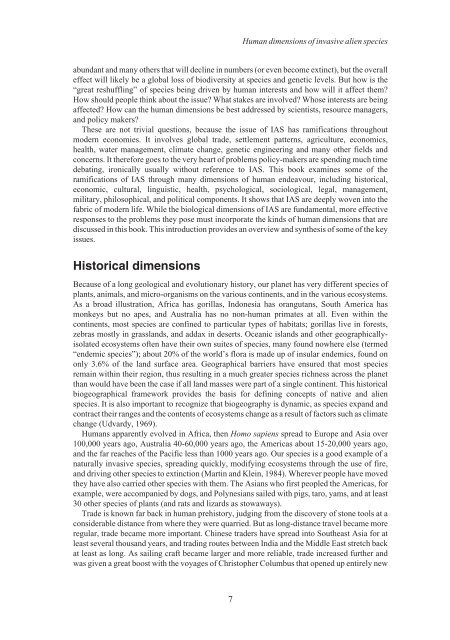Alien Species.vp - IUCN
Alien Species.vp - IUCN
Alien Species.vp - IUCN
You also want an ePaper? Increase the reach of your titles
YUMPU automatically turns print PDFs into web optimized ePapers that Google loves.
abundant and many others that will decline in numbers (or even become extinct), but the overall<br />
effect will likely be a global loss of biodiversity at species and genetic levels. But how is the<br />
“great reshuffling” of species being driven by human interests and how will it affect them?<br />
How should people think about the issue? What stakes are involved? Whose interests are being<br />
affected? How can the human dimensions be best addressed by scientists, resource managers,<br />
and policy makers?<br />
These are not trivial questions, because the issue of IAS has ramifications throughout<br />
modern economies. It involves global trade, settlement patterns, agriculture, economics,<br />
health, water management, climate change, genetic engineering and many other fields and<br />
concerns. It therefore goes to the very heart of problems policy-makers are spending much time<br />
debating, ironically usually without reference to IAS. This book examines some of the<br />
ramifications of IAS through many dimensions of human endeavour, including historical,<br />
economic, cultural, linguistic, health, psychological, sociological, legal, management,<br />
military, philosophical, and political components. It shows that IAS are deeply woven into the<br />
fabric of modern life. While the biological dimensions of IAS are fundamental, more effective<br />
responses to the problems they pose must incorporate the kinds of human dimensions that are<br />
discussed in this book. This introduction provides an overview and synthesis of some of the key<br />
issues.<br />
Historical dimensions<br />
Because of a long geological and evolutionary history, our planet has very different species of<br />
plants, animals, and micro-organisms on the various continents, and in the various ecosystems.<br />
As a broad illustration, Africa has gorillas, Indonesia has orangutans, South America has<br />
monkeys but no apes, and Australia has no non-human primates at all. Even within the<br />
continents, most species are confined to particular types of habitats; gorillas live in forests,<br />
zebras mostly in grasslands, and addax in deserts. Oceanic islands and other geographicallyisolated<br />
ecosystems often have their own suites of species, many found nowhere else (termed<br />
“endemic species”); about 20% of the world’s flora is made up of insular endemics, found on<br />
only 3.6% of the land surface area. Geographical barriers have ensured that most species<br />
remain within their region, thus resulting in a much greater species richness across the planet<br />
than would have been the case if all land masses were part of a single continent. This historical<br />
biogeographical framework provides the basis for defining concepts of native and alien<br />
species. It is also important to recognize that biogeography is dynamic, as species expand and<br />
contract their ranges and the contents of ecosystems change as a result of factors such as climate<br />
change (Udvardy, 1969).<br />
Humans apparently evolved in Africa, then Homo sapiens spread to Europe and Asia over<br />
100,000 years ago, Australia 40-60,000 years ago, the Americas about 15-20,000 years ago,<br />
and the far reaches of the Pacific less than 1000 years ago. Our species is a good example of a<br />
naturally invasive species, spreading quickly, modifying ecosystems through the use of fire,<br />
and driving other species to extinction (Martin and Klein, 1984). Wherever people have moved<br />
they have also carried other species with them. The Asians who first peopled the Americas, for<br />
example, were accompanied by dogs, and Polynesians sailed with pigs, taro, yams, and at least<br />
30 other species of plants (and rats and lizards as stowaways).<br />
Trade is known far back in human prehistory, judging from the discovery of stone tools at a<br />
considerable distance from where they were quarried. But as long-distance travel became more<br />
regular, trade became more important. Chinese traders have spread into Southeast Asia for at<br />
least several thousand years, and trading routes between India and the Middle East stretch back<br />
at least as long. As sailing craft became larger and more reliable, trade increased further and<br />
was given a great boost with the voyages of Christopher Columbus that opened up entirely new<br />
7<br />
Human dimensions of invasive alien species












